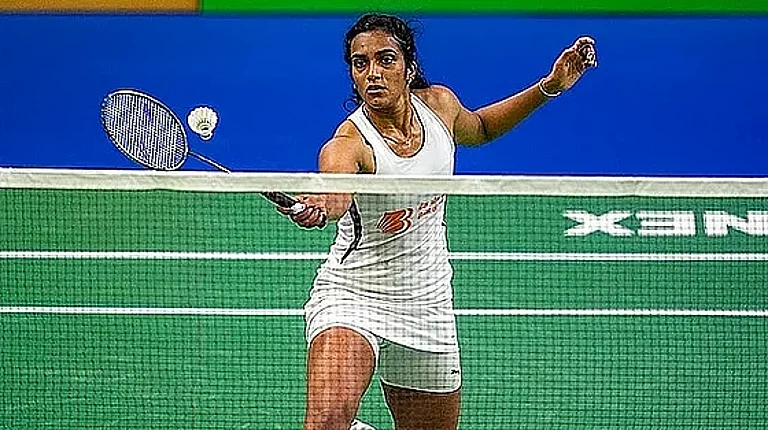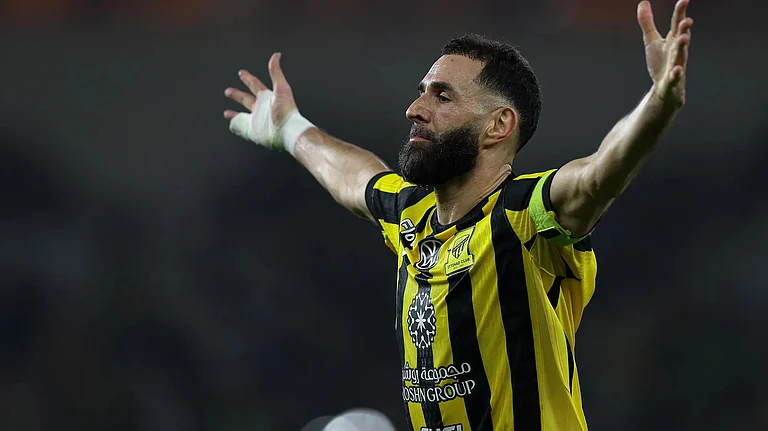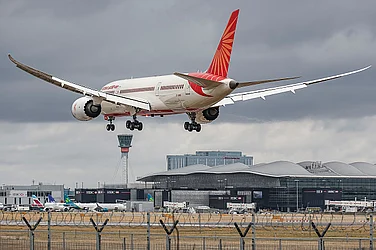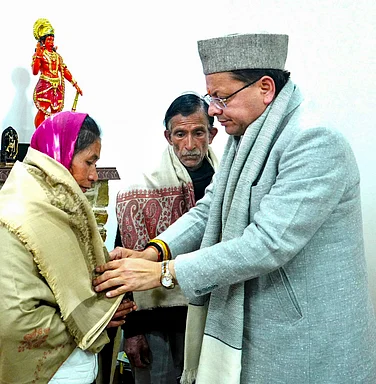One of India’s most prominent public intellectuals, who has survived 17 months of the Modi sarkar despite being an appointee of the Manmohan sarkar, was at a dinner in Delhi last Wednesday. As naturally as night follows day, the chatter swerved towards the frozen meat of a mute animal, and how the suspected temporary habitation of bits of it in a refrigerator 56 km from the national capital had become the leitmotif of a liberalism in crisis. “Six Union cabinet ministers,” said the gentle scholar without a hint of bragging, “four of whom I had not met before or was personally acquainted with, telephoned last weekend congratulating me for my article urging the prime minister to speak up against the rising tide of intolerance.”

After the arson attack on the St Sebastian church, Delhi. (Photograph by Tribhuvan Tiwari)
As he spoke, in presses printing The Economic Times across the country, the words of former BJP president and Union minister Nitin Gadkari were being inked into posterity. “If (Narendra Modi) speaks, they will ask, ‘why did he speak?’ If he does not speak, they will say ‘why doesn’t he speak?’ Is it the PM’s job to speak about every incident?” asked Gadkari, who hails from the currently crucial central Indian city of Nagpur. “There’s the home minister and other ministers. Did Manmohan Singh speak on all issues?” And so, in the eyes of a minister said to be the apple of the RSS’s eye, Mohammed Akhlaq’s lynching, merely because of his suspected source of protein, was just another “incident” not worthy of the prime minister’s attention.
It probably was. In the first 11 days since Akhlaq’s sudden murder, Narendra Modi tweeted about 82 times. He wished Lata Mangeshkar on her birthday and commiserated with Asha Bhonsle on the loss of her son. He sent his greetings to the people of China on their national day. He congratulated Pankaj Advani on winning the world billiards championship. He wished Navjot Sidhu a speedy recovery. Why, he even greeted his cabinet colleague Dr Mahesh Sharma, praying for his “good health and long life”. But somehow those handling Modi’s Twitter account could not find 140 characters to mention, lament, mourn or condemn the abrupt end to the good health and long life of Mohammed Akhlaq of village Bisara, at age 55...
- Or the killing of the Kannada writer and rationalist M.M. Kalburgi
- Or the ban on meat sale in Maharashtra, Chhattisgarh, Haryana, Rajasthan
- Or the attacks on churches here, there, everywhere
- Or his colleagues urging Muslims to go to Pakistan
- Or his ministerial colleague who made the distinction between ‘ramzaadon’ and ‘haramzaadon’
- Or the loud campaign for ‘ghar wapasi’ or its country cousin, ‘love jehad’
- Or the freeze on antagonistic ngos like Greenpeace and Ford Foundation
- Or the attacks on rights activists like Teesta Setalvad and John Dayal.
In the end, when Modi did briefly open his mouth in Bihar on the 12th day, it was as if he was only taunting Nitin Gadkari of Nagpur. No more. A day after President Pranab Mukherjee reminded the rulers of their “raj dharma” in a roundabout replay of Atal Behari Vajpayee in 2002—“that we should not allow the core values of our civilisation, diversity, plurality and tolerance to wither away”—Modi exhorted people to follow the President’s message. “Hindus and Muslims should work together to fight poverty. India has to stay united. Only communal harmony and brotherhood will take the nation forward,” he said. But still, no mention of Dadri or Mohammed Akhlaq by name. Still no condemnation of the moral police for intruding into the kitchen of a citizen questioning his liberty to eat what he wanted. Still no condemnation of his “culture” colleague who saw the death as an “accident”.

Akhlaq’s family meets UP CM Akhilesh Yadav in Lucknow. (Photograph by Nirala Tripathi)
True, the “incident” took place in Samajwadi Party-governed Uttar Pradesh. True, law and order is a state subject. Still, as liberal media and civil society rose as one, as writers like Nayantara Sehgal and Ashok Vajpeyi returned their honours, it was clear that a little town 30 miles from the PM’s residence had emerged as an inflection point to regain a liberal ethos rapidly crumbling under the sustained assaults of the Hindutva Hitmen. “When historians sit in judgement of India 50 years from now, the murder of Mohammed Akhlaq in Dadri will be seen as an event on par with the demolition of the Babri mosque in Ayodhya in 1992 as a national moral nadir,” wrote the commentator Tunku Varadarajan in The Indian Express.
It is anybody’s guess if Modi would have uttered even those few words of harmony if the Bihar election wasn’t around the corner, and if the RJD’s Laloo Prasad Yadav and mim’s Asaduddin Owaisi hadn’t joined the debate. But it was clear that whoever did what they did in Dadri were emboldened by the electoral success of the gameplan that was executed in Muzaffarnagar in 2013. According to home ministry figures, communal violence is up nearly 30 per cent this year. Of the 51 persons killed, 31 were Muslims. Worse, Uttar Pradesh and Bihar accounted for half the death toll. Half the 6,438 incidents of riots occurred in western UP where Muzaffarnagar and Dadri are located.

Union culture minister Mahesh Sharma (in white kurta) visiting Akhlaq’s son Danish in hospital
Clearly, the Dadri plan was to polarise Hindu votes in poll-bound Bihar and keep the embers burning at least until the UP elections in 2017. “Beef was just a peg in the communal cauldron,” says former finance secretary S.P. Shukla. “It’s part of a systematic campaign to incite communal tension to divert attention from the main issues—agrarian crisis to food crisis and development.” Adds Modi’s biographer Nilanjan Mukhopadhyay: “Dadri should not be seen as an organised event. It is a reflection of the growing communal hatred in Indian society. If we view the Dadri incident as a planned attack, then we will make the mistake of equating the political problem of communalism with a mafia-style operation.”
The timing of the Death in Dadri, as the PM was winging his way back from a triumphant tour of Silicon Valley, at once showed the dichotomy and the dissonance of the Modi sarkar. On the one hand is a forward-looking prime minister speaking the language of the future. And on the other, revanchist communal forces drawing succour and sustenance from non-state actors backing the PM, looking into the rearview mirror at the past. For many, though, the difference was too subtle to even take note of. After all, it was Modi who had repeatedly invoked the image of the “pink revolution”, a precursor of the anti-beef campaign. “Why would the man primarily responsible for evoking outrage among Hindus during the previous general election campaign now rein in those who are fanning the flames he lit in villages across north India?” asked commentator Girish Shahane on Scroll.

Akhlaq’s mother Asgari Begum at her home in Bisara village. (Photograph by Jitender Gupta)
Prior to his second trip to the United States last fortnight, Modi’s media meisters put out statistics that showed that his first trip there (in September last year) had fetched him 27,639 words against the 7,596 words Manmohan Singh had got four years earlier. But even before he could land home in 2015, the US media had used more words and more airtime on the few minutes of infamy in Dadri than his sojourn in Silicon Valley.
“A line has been crossed. The manner in which Mohammed Akhlaq was lynched was reminiscent of Ehsan Jafri except that it was not even in the context of communal conflict, it was based on rumour,” says the actress Sharmila Tagore. “This lynching should not be seen in isolation. It has to be seen in the context of what has been happening regularly in the past year and how the ambit of impunity is steadily increasing. Now some are emboldened to think that they can literally get away with murder. And they do.”


























